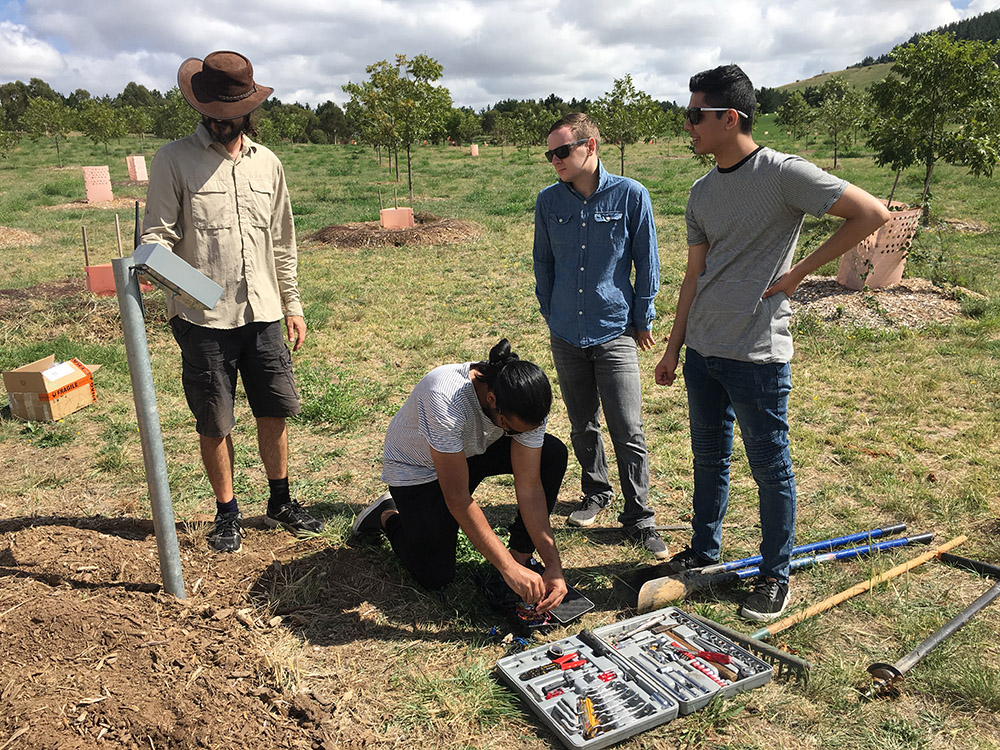Newsroom team
24 December 2018: A University of Canberra research project in Internet of Things (IoT) technology has dramatically altered the National Arboretum’s approach to forest care.
A group of researchers, led by University of Canberra Assistant Professor of Network Engineering, Dr Kumudu Munasinghe, and Research Associate, Dr Adrian Garrido Sanchis, designed and installed the state-of-the-art Smart IoT Platform to monitor pertinent soil data at the National Arboretum Canberra.
The IoT platform collects soil moisture and temperature data using research-grade sensors buried at various depths in forests. These sensors are connected to UC’s proprietary smart sensor platform which transmits the information via a synchronous, self-sustained, Wireless Sensor Network (WSN) to a central gateway, and is processed and uploaded to a secure cloud server.
Dr Munasinghe and his team also developed some advanced analytic algorithms that process the IoT data to deliver important environmental knowledge of forests over time.
“We worked with the Arboretum staff to understand their current processes, and how we could leverage our technologies to deliver an innovative system that provides what they needed and we’ve been seeing great results from day one” Dr Munasinghe said.
Dr Munasinghe says the IoT nodes are internetworked using an advanced wireless mesh networking backbone that connects to the Internet to allow the Arboretum staff to access the information from mobile devices anytime and anywhere via the cloud.
“Since the information that is gathered is hosted by the cloud, it is accessible via any smart device whether staff are among the trees themselves, or at an off-site location.”
The system optimises irrigation and promotes greater tree growth while curbing water wastage. It also shows in detail how saturated the site-specific soil is getting, and how long it takes to dry across the entire Arboretum site in real-time.
Previously, soil saturation levels were monitored by an Arboretum staff member walking through the 250 hectare site taking manual readings for 104 forests with a probe. Due to the cumbersome nature of this manual data collection, only one reading per forest, per month could be recorded.
With UC’s Smart IoT Platform, Arboretum staff can now get on-demand, real-time soil moisture readings up to every minute during an irrigation or rain fall event, while dynamically scaling back to 30 minutes during night time or other low-interest periods.
The smart IoT platform has the capability of intelligently adjusting the sampling frequency to ensure sustainable power management. For example, based on rain forecasts and sunlight hours, it will automatically and pre-emptively adjust the sampling frequency, allowing the solar powered network to self-sustain.
The project has been researched for a number of years with Phase 1 delivered in 2016 as a pilot program covering just one forest. Phase 2 in 2018 delivered coverage for ten forests, with the hope that with further funding next year, the remaining forests will be monitored under the platform.
The project with the Arboretum has been incredibly beneficial for the University’s strategic direction on Work Integrated Learning (WIL). Under this program, UC has been able to host five engineering honours projects and work experience/internships, which are mandatory requirements by Engineers Australia.
Dinusha Sandirigama, Sushant Ghimire and Jade Chitts, the three student engineers that worked on Phase 2 of the project, were also awarded third prize at Engineers Australia’s highly regarded Undergraduate Project Presentation Competition for 2018.
The bespoke sensor board utilised by the deployed sensor nodes were custom-designed by the University of Canberra’s Human centred Technology’s IoT research labs. It is the product of a rigorous one-year research and development phase funded by the Discovery Translation Fund 2 (DTF2) scheme by ANU Connect Ventures.
Apart from the successful deployment of the Smart IoT Platform at the National Arboretum, the University has just received its first purchase order from the Queanbeyan-Palerang Regional Council (QPRC) under the Federal Government’s Smart Cities and Suburbs Program.
There is optimism that every council and Arboretum in Australia will see the value in sustainable water management through smart monitoring of soil saturation levels through this innovative system.



